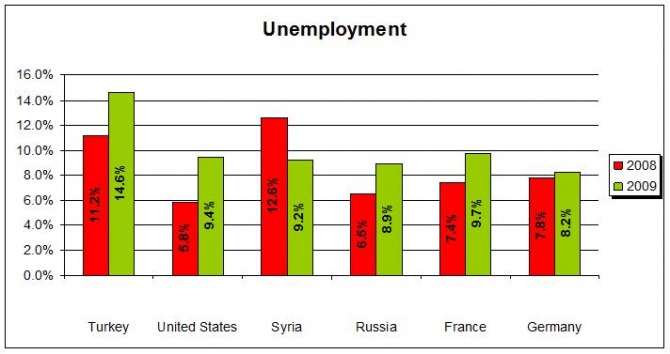Economic Status of Turkey
The second economic goal is low unemployment. One factor that may be affecting Turkey’s high unemployment rate could possibly be the three-year drought, which would be cyclical unemployment. Turkey’s 2009 population was 76,805,524 with 14.6% unemployed, which is a 3.4% increase from 2008. According to NationMaster, the 2004 Turkish total labor force was 23,530,000 with 35.9% employed in agriculture, 22.8% employed in industry, and 41.2% employed in services. Of the 2004 labor force, only 60.1% have a primary education, 6.1% have secondary education and 8.3% have tertiary education (www.nationmaster.com).
According to Deborah Amos, a writer for National Public Radio, the three-year drought has not only affected bordering countries, it is also having impact on southeast Turkey. If the drought continues, not only will the agriculture industry be affected by reducing the number of crops that can be planted, the food processing and lumber processing plants will also be affected employing fewer number of people. (www.npr.org).
According to the Index of Economic Freedom, Turkey is considered moderately free with a rating of 63.8; however, their Labor Freedom is ranked 41.1. “Turkey’s labor regulations are inflexible. The non-salary cost of employing a worker is high, and dismissing an employee is difficult. The rigid labor market results in high unemployment and has contributed to the formation of a large informal sector” (www.heritage.org). This information is helpful in understanding why the unemployment rate is so high and that loosening of regulations would be beneficial.
Structural unemployment has also been affected with a lack of higher education among the labor force because the workers are not qualified to work in other industries. Turkey’s entrepreneurial ability is also affected by the lack of higher education, which puts the country at a disadvantage for having the necessary skills to be successful in the marketplace.
According to NationMaster, females make up 72% of the agricultural workers compared to 34% of males working in the agriculture industry. In the industry sector, females make up 10% of the labor force compared with 25% males. The service industry is made up of 18% female and 41% males. The gender gap in the agriculture, industry and service industry is significant but is greatest in the agricultural industry. (www.nationmaster.com).
Females with a secondary education have an unemployment rate of 39.7% compared to 25.7% males with a secondary education. While 23.2% of females with a tertiary education are unemployed and 9.2% of males with a tertiary education are unemployed, overall, females have higher unemployment rates regardless of the education level (www.nationmaster.com).
Compared to the United States’ unemployment rate of 9.4% it appears that Turkey’s rate is significantly higher, however, when considering the U.S. 207,212,123 population size, the increased unemployment rate from 2008 to 2009 increased at almost the same rate as the U.S. Syria was the only comparison country that had a decrease in their unemployment rate by 3.4%. Russia and France both experienced an increase in unemployment rate by 2.4% and 2.3% respectively. Germany, however, had a slight increase in their unemployment rate from 2008 to 2009 by only 0.4%.
According to Deborah Amos, a writer for National Public Radio, the three-year drought has not only affected bordering countries, it is also having impact on southeast Turkey. If the drought continues, not only will the agriculture industry be affected by reducing the number of crops that can be planted, the food processing and lumber processing plants will also be affected employing fewer number of people. (www.npr.org).
According to the Index of Economic Freedom, Turkey is considered moderately free with a rating of 63.8; however, their Labor Freedom is ranked 41.1. “Turkey’s labor regulations are inflexible. The non-salary cost of employing a worker is high, and dismissing an employee is difficult. The rigid labor market results in high unemployment and has contributed to the formation of a large informal sector” (www.heritage.org). This information is helpful in understanding why the unemployment rate is so high and that loosening of regulations would be beneficial.
Structural unemployment has also been affected with a lack of higher education among the labor force because the workers are not qualified to work in other industries. Turkey’s entrepreneurial ability is also affected by the lack of higher education, which puts the country at a disadvantage for having the necessary skills to be successful in the marketplace.
According to NationMaster, females make up 72% of the agricultural workers compared to 34% of males working in the agriculture industry. In the industry sector, females make up 10% of the labor force compared with 25% males. The service industry is made up of 18% female and 41% males. The gender gap in the agriculture, industry and service industry is significant but is greatest in the agricultural industry. (www.nationmaster.com).
Females with a secondary education have an unemployment rate of 39.7% compared to 25.7% males with a secondary education. While 23.2% of females with a tertiary education are unemployed and 9.2% of males with a tertiary education are unemployed, overall, females have higher unemployment rates regardless of the education level (www.nationmaster.com).
Compared to the United States’ unemployment rate of 9.4% it appears that Turkey’s rate is significantly higher, however, when considering the U.S. 207,212,123 population size, the increased unemployment rate from 2008 to 2009 increased at almost the same rate as the U.S. Syria was the only comparison country that had a decrease in their unemployment rate by 3.4%. Russia and France both experienced an increase in unemployment rate by 2.4% and 2.3% respectively. Germany, however, had a slight increase in their unemployment rate from 2008 to 2009 by only 0.4%.

